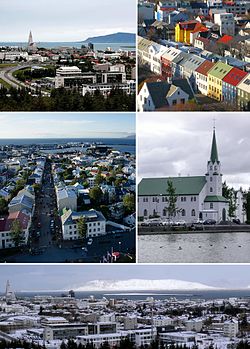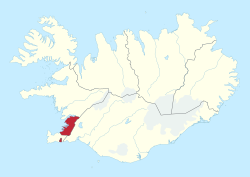Capital Region (Iceland)
Capital Region
Höfuðborgarsvæðið | |
|---|---|
 From upper left: Reykjavík from Perlan, rooftops from Hallgrímskirkja, Reykjavík from Hallgrímskirkja, Fríkirkjan, panorama from Perlan | |
 | |
| Coordinates: 64°11′05″N 21°36′47″W / 64.1846°N 21.6131°W | |
| Country | Iceland |
| Area | |
| • Total | 1,062.2 km2 (410.1 sq mi) |
| Population (2022) | |
| • Total | 240,882 |
| • Density | 226.8/km2 (587/sq mi) |
| Time zone | UTC+0:00 (GMT) |

The Capital Region (Template:Lang-is [ˈhœːvʏðˌpɔrkarˌsvaiːðɪθ]) is a region in southwestern Iceland that comprises the national capital Reykjavík and six municipalities around it.[1][2] Each municipality has its own elected council. Municipal governments in the region cooperate extensively in various fields: for example waste policy, shared public transport and a joint fire brigade. The region is home to 64% of Iceland's population.
The region contains Icelands far largest urban area, Greater Reykjavík (Template:Lang-is), a conurbation that includes parts of six out of seven municipalities of the region (Kjósarhreppur is all rural).
Municipalities
Seven municipalities make up the Capital Region with Reykjavík being the most populated by far with 135,688 inhabitants. Kjósarhreppur is the largest municipality by area (287.7 km2 (111.1 sq mi)) but is entirely rural and only has 244 inhabitants. Seltjarnarnes is the smallest municipality with an area of 2.3 km2 (0.89 sq mi).
| Municipalities | Population (1 January 2022)[3] | Area (km2)[4] | Density (Pop/km2) |
|---|---|---|---|
| Reykjavík | 135,688 | 277.1 | 489.7 |
| Kópavogur | 38,998 | 83.7 | 465.9 |
| Hafnarfjörður | 29,763 | 143.3 | 207.7 |
| Garðabær | 18,445 | 74.4 | 247.9 |
| Mosfellsbær | 13,024 | 193.7 | 67.2 |
| Seltjarnarnes | 4,720 | 2.3 | 2052.2 |
| Kjósarhreppur | 244 | 287.7 | 0.8 |
| Total | 240,882 | 1,062.2 | 226.8 |
Urban areas
Statistics Iceland has defined contiguous urban areas which ignore municipal boundaries. An urban area may straddle multiple municipalities and a single municipality may contain more than one urban area.
| Urban area | Population (1 January 2022)[5] | Municipalities |
|---|---|---|
| Greater Reykjavík | 236,518 | Reykjavík Kópavogur Hafnarfjörður Garðabær Mosfellsbær Seltjarnarnes |
| Álftanes | 2,530 | Garðabær |
| Grundarhverfi | 535 | Reykjavík |
| Mosfellsdalur | 262 | Mosfellsbær |
| Rural | 1,037 | |
| Total | 240,882 |
References
- ^ Association of municipalities in the Capital area English version Retrieved on 5. June 2010
- ^ Sigurður Guðmundsson. „Hvernig eru hugtökin dreifbýli og landsbyggð skilgreind hér á landi?“ The Icelandic Web of Science. 18.8.2000. Retrieved on 6. June 2010 (In Icelandic)
- ^ "Population by municipalities, sex and age 1 January 1998-2022 - Division into municipalites as of 1 January 2022". www.hagstofa.is. Statistics Iceland. 1 January 2022. Retrieved 4 October 2022.
- ^ National Land Survey of Iceland. Sveitarfélagaskjárinn. Retrieved on 6. June 2010 (In Icelandic)
- ^ "Population by localities, sex and age 1 January 2001-2022". www.hagstofa.is. Statistics Iceland. 1 January 2022. Retrieved 4 October 2022.
External links
 Southwest Iceland travel guide from Wikivoyage
Southwest Iceland travel guide from Wikivoyage
64°08′00″N 21°56′00″W / 64.13333°N 21.93333°W

